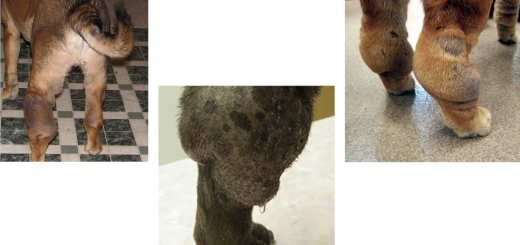Pregnancy Information:
- Check for pregnancy 30 days after last breeding via palpation, relaxin blood test or ultrasound examination.
- Feeding the bitch:
- 5th week of pregnancy – increase food by 25%
- 6th week of pregnancy – increase feeding by 50%
- 7th week of pregnancy – increase feeding by 75%
- 8th week of pregnancy and lactation- free choice feeding.
Also feed the bitch smaller meals more often as the pregnancy progresses since the stomach is being crowded by the developing pups. Regular adult maintenance diet is fine and no supplements are needed due to the increase in food being consumed.
- X-ray bitch at day 50 or so after the last breeding to get a rough count of the number of pups.
- The gestation period in a dog is 63 days from conception or 9 weeks. Each week represents 1 month in a human pregnancy.
- Exercise the bitch during her pregnancy and don’t let her get overweight. Extra weight makes for a more difficult delivery.
- Build a whelping box in advance so the bitch can get use to it. I feed them in it and train them to stay in it for short period of time. It should have a “puppy” rail for pups to get under along the walls so they don’t get laid on by the bitch. A plastic children’s wading pool makes a good whelping box also.
- Whelping supplies:
- towels
- scissors
- alcohol to clean instruments
- paper and pencil to keep records
- clock or watch
- a “ready” box with towels to hold pups while mom is delivering the next pup
- hot water bottle
- paper towels
- newspapers
- garbage bags
- veterinarian/emergency clinic phone numbers
- whelping book – The Whelping and Rearing of Puppies by Muriel P. Lee, Plantin Press, PO Box 905, Minneapolis, MN 55440
- gram/ounce scale
- hemostats (ear-plucking forceps)
- dental floss to tie umbilical cords
- coffee and coffee pot and something to read between delivery of pups
- pediatric ear bulb syringe
- 7-10 days prior to whelping you will be able to express milk from the dam’s nipples. Monitor the dam’s temperature rectally twice a day during the last two weeks of the pregnancy. Normal is 101-102 degrees Fahrenheit and 24-48 hours prior to whelping the temperature will drop to 99 degrees or less and stays down. Near the end of the pregnancy there will be a fair amount of a clear mucous vaginal discharge.
- If no pups by day 63 after last breeding call your veterinarian
- If colored vaginal discharge call your veterinarian.
- Whelping begins at the onset of abdominal contractions. Whelping is stressful and the minimal number of people necessary should be present with the dam. No observers, children, other animals, etc. When whelping starts the owner should be available but not “hovering”, babying or cuddling which makes the dam nervous. The dam needs to be focused and not distracted during the birth process.
- The birth process usually starts 20 minutes to 2 hours after the contractions start.
- The waterbag appears first – it is a dark, water-balloon-like structure containing the puppy. Sometimes the waterbag breaks before you see it and all you see is the fluid.
- Pups are usually delivered in groups of two anywhere from 15 minutes to 3 hours – usually there is 20 minutes between pups in a group of two as an average.
- The pup is delivered often with the afterbirth attached by the umbilical cord. If the waterbag is still intact you may have to rip it open for the dam. The bitch licking the pup vigorously usually stimulates the pup to start breathing. Let the bitch cut the cord or you can cut it about 2 inches from the pup’s body. You can tie off the cord with the dental floss.
- Record keeping is important and usually includes when the labor starts, when the pups are born, the sex of the pups, the color and markings of the pups, weight of the pups and whether the afterbirth is passed for each pup.
- The bitch will often eat the afterbirth but that is not necessary and actually can cause diarrhea.
- If you have to assist in the delivery the following guidelines are useful:
- be sure the amniotic sac (“waterbag”) is removed from the puppy soon as possible starting at the head so the pup can breathe immediately. The first priority is to get the pup breathing!
- use the pediatric ear bulb syringe to gently suck secretions out of the mouth and nose of the pup.
- use the towels to hold the pup (they are very slippery!) and to vigorously rub the pup to get it breathing and to dry it off.
- The pups should be put with mom as soon as possible but they may not nurse right away. Remove the pups when the dam starts to deliver another pup – she may sit or lay on the pups while she is distracted.
- DANGER SIGNS – CALL THE VETERINARIAN OR THE EMERGENCY SERVICE:
- No pups produced after 2-3 hours of labor or ½ hour of hard labor.
- A puppy is stuck in the birth canal.
- Uterine inertia – weak, non-productive contractions with no pups being delivered or several pups are delivered normally in a large litter (based on X-ray) but then the bitch stops labor or has weak, ineffective contractions.
An excellent layman’s book for pregnancy and whelping is The Whelping and Rearing of Puppies: A Complete and Practical Guide by Muriel P. Lee, published by Plantin Press, P.O. Box 905, Minneapolis, MN 55440.
